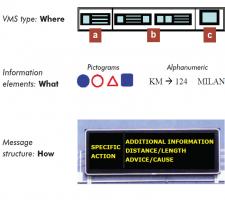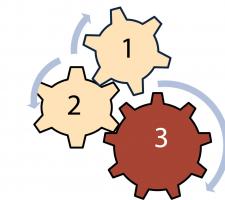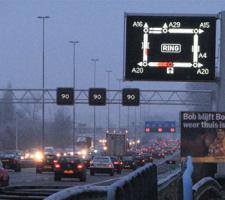
ES4-Mare Nostrum builds up harmonisation following a fixed procedure, and combines knowledge on traffic management priorities at the EU level, with empirical methods
Alberto Arbaiza, ES4-Mare Nostrum Chair, Directorate General of Traffic, Spain and Antonio Lucas-Alba, ES4 Secretariat, INTRAS, University of Valencia, Spain write about progress towards variable message sign harmonisation in Europe
Particularly in Europe, national road administrations have been faster at generating and adopting new road signs than the standardisation process has been at generating them.The Mare Nostrum VMS (Variable Message Sign) project originated informally, when officials from different European countries realised that quicker progress towards VMS harmonisation required sharing explicitly the VMS design parameters in use as well as a pragmatic cooperation context: operators sharing similar VMS devices and road/traffic problems. The first meeting was held in Rome, including partners from France, Italy and Spain (chairing the group). Since then Mare Nostrum has become larger, incorporating the Netherlands early in 2004, and Portugal, the Republic of Ireland, Slovenia, Sweden and the United Kingdom late in 2006. In 2007 under the Easyway programme (2007-2013), the group was renamed European Study 4-Mare Nostrum. Late in 2008 Denmark, Greece and Hungary joined ES4-Mare Nostrum too, being now constituted by 12
The need for harmonisation
Road signs have a long history. Their greatest and latest development, the process of the international standardisation of road signs, goes back a century (Paris, 1909) and culminated some 40 years ago, when the Convention of Road Signs and Signals (Vienna, 1968) was agreed. As German semiotician Martin Krampen has so notably analysed, this long process has brought on a consolidated semiotic structure and functions, colours, shapes and contents of road signs have been adopted and disseminated throughout the main geographic areas in the world (the US, Europe, China, Africa and so on). Although not without drawbacks, this background is solid enough to guide and pre-determine the design of new and improved road signs, as VMS.The international signing context requires a swift update of signing means and elements. However UNECE's 1968 Convention changes at a slow pace. The idea is that best national signing practices arrive to UNECE WP.1 (Working Party on Road Safety 1) once such (real) practices have consolidated in a number of nations. Typically, officials explain the benefit of introducing for example a new sign to WP.1. After some scrutiny the new sign can be included in the so-called Consolidated Resolution 2 (RE.2), a portfolio of cumulative signing practices that will amend and enlarge the 1968 Convention. When the amendment comes, new signs are introduced and WP.1 members have about 10 years to include these innovations in their respective legal codes. The first (and only) amend to the 1968 Convention introducing relevant VMS contents took place in 1995, when the congestion pictogram and the possibility of using colour inversion were adopted.
In the last few decades, new display formats (VMS, RDS-TMC, navigators) have introduced new possibilities and needs. A sign indicating a coming ghost driver has really no sense in posted format but makes sense on VMS and even more sense displayed in-car. In the early 1980s, new information technologies made evident the lacking signing dimensions of the 1968 Convention.
Through the 1990s national road administrations experimented with new signs for their respective VMS devices and operators became increasingly aware of the road/traffic management possibilities brought about by VMS. Nothing was specifically addressed by UNECE concerning these matters, and the national perspective prevailed. Particularly in Europe, pulled by industrial dispositions, national road administrations were faster at generating and adopting new road signs than WP.1 was at standardising them. The result was a Europe-wide lack of road signs harmonisation within the new and expanding domain of VMS.
The obstacles to harmonisation
Three main obstacles to harmonisation can be discerned, at least at the European level. The first and most obvious one is language. There are 27 Member States with almost 500 million people speaking no less than 24 official languages within the EU. Harmonisation should proceed according to pictograms, not words, as the 1968 Convention recommends. The second obstacle is the different VMS devices that allow for differing combinations of pictogram/text. The third obstacle is the (un)availability and comprehensibility of abstract signs or pictograms. The key aspect of harmonisation is where, what, and how information should be displayed on VMS (Figure 1).'Where' refers to VMS device type. ES4's main focus has been panels combining pictograms and text. However, there are several types of VMS, some having just text, others having one graphical part, others having two pictograms and others being able to display pictograms and text freely (full-matrix).
'What' means the informative elements used: pictogram and alphanumeric elements. ES4 has prioritised rules so pictograms are the most important element on any VMS. For example, specific pictograms (for example, for congestion), are preferred to generic ones (plain 'danger') because the former need less complementary text. Abstract alphanumeric (such as equals signs or arrows) are preferred to prepositions and conjunctions.
'How' refers to the way informative elements are structured on the VMS. The main reference is the Framework for Harmonised Implementation of VMS in Europe (FIVE) (1997-2004). FIVE gives recommendations for information placement according to main road signing functions (regulatory, danger warning, informative). FIVE's recommendations make us aware of such issues as information location, order and structure. However, such recommendations would only work with VMS with an unlimited set of characters per line. Many VMS have 12-18 characters per line and some informative elements are very long and frequently break the proposed distribution. On the other hand, full-matrix VMS can display four lines of text. Further work is needed to make structuring principles more shareable.
Chosen methodology
ES4-Mare Nostrum grounds the harmonisation task on three main activities (Figure 2).Firstly, partners share their views concerning a) which road/traffic events are important and have priority and b) the specific VMS messages displayed by the partners. This information, provided by the real users (VMS operators), constitutes the basic ground for appraising the main hindrances towards harmonisation in Europe, be it lack of general design principles, of common pictograms, or message structures. The result is compiled in the Working Book (WB). The third edition of the Working Book is expected at the end of 2010.
Partners then solve the problems detected and put these together in the WB. Potential solutions must be international, following documents as the 1968 Convention. Problem-solving includes plain consensus or empirical work. New signing formulations (pictograms, alphanumeric) are empirically studied following the Four-Step Method, a combination of ISO tests for signs comprehension (Steps 1 and 2), laboratory (Step 3) and field tests (Step 4).
Finally, partners propose harmonised VMS that could be used in Europe considering the specific road/traffic situation and five main types of VMS in use. That is, the pragmatic contribution that should be expected at the European level concerning VMS design for a variety of road/traffic situations (congestion, slippery surface, bad visibility, pre-announcements and so on). The result is compiled in The ES4 Guidelines. The WB and the ES4 Guidelines hold the same structure of road/traffic events, the former preceding the later on time and advancing the contents that will be harmonised.
Progress and problems to date
Two main problems are faced by ES4-Mare Nostrum. The first concerns the identification and adoptions of the road signs that can make a road/traffic situation easy to harmonise. ES4 makes the most of the respective national programmes, sharing updated information of signs that partners test and incorporate. Still, pictograms are not easy to find, test and share convincingly by all countries to the same extent. The solution for this problem is empirical success or empirical relevance, all through the Four-Step Method. For example, empirical success is achieved when pictogram tests obtain comprehension rates of more than 70 per cent (ISO, Step 2) on the average for ES4 members. Relevance would involve pictograms with comprehension rates of 50-70 per cent - that is, pictograms that could be retested or given a particular treatment (such as official, controlled dissemination of new signs).The second problem concerns the standardisation of VMS informative elements (pictograms, alphanumeric) and design principles. The solution for this problem is a) disseminating VMS harmonisation de facto and b) proposing amends to the 1968 Convention (UNECE). The first point is dealt with via the ES4 Guidelines (vid supra), a document that includes more than 30 design principles for writing VMS and a number of recommendations for specific road/traffic situations just in the way they would look like in different VMS types. The second edition of the ES4 Guidelines is expected for 2011.
Point b) in the last paragraph requires participation at UNECE's WP.1. Back in 2003, France, Germany, the Netherlands and Spain (chairing the group), proposed to WP.1 the possibility of forming an ad hoc group for setting up VMS design recommendations that would be incorporated into the 1968 Convention. WP.1 accepted, giving way to the Small Group on VMS (2003-2008). The Small Group (75 per cent Mare Nostrum) proposed a number of measures (including design recommendations and new signs) that passed to RE.2 late in 2008 and now wait for the next amend of the 1968 Convention. Conscious of the extraordinary importance of updating the Convention, the Small Group proposed late in 2009 the creation of a new ad hoc group, the VMS Unit (85 per cent ES4-Mare Nostrum), where Italy, Sweden, and the UK also participate. The VMS Unit work plan will be discussed in Geneva in March 2010.
Next steps
As Figure 2 indicates, ES4-Mare Nostrum builds up harmonisation following a fixed procedure, and combines knowledge on traffic management priorities at the EU level, with empirical methods (the next empirical tests will take place in March 2010) and with diffusion of results (VMS recommendations). ES4-Mare Nostrum intends that the different Member States involved adopt the recommendations on the ES4-Guidelines in their respective national codes and VMS Guidelines (for example, Italian and Spanish current VMS Guidelines). At the same time, ES4 very actively supports updating of the 1968 Convention at the UNECE level, working very closely with the VMS Unit.The authors are gratefully indebted to all members of ES4-Mare Nostrum: Paul Whitehead (















